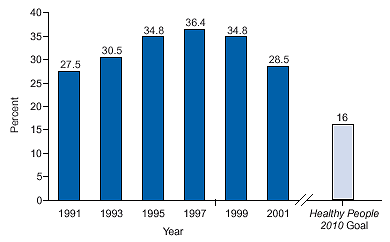
|

|

How Tobacco
Control Saves Money
- The State of
California estimates that their program has resulted in an overall
cost savings of $8.4 billion. For every $1 spent on the program
between 1990 and 1998, an estimated $3.62 in direct medical costs were
avoided.
- Smokers who
successfully quit smoking reduce the anticipated medical costs
associated with heart attack and stroke by an estimated $47 in the
first year and $853 during the following 7 years.
- Recent studies have
concluded that reducing smoking prevalence among pregnant women by one
percentage point over 7 years would prevent 57,200 low-birth-weight
births and save $572 million and that every $1 invested an effective
school-based tobacco prevention program saves $19.90 in associated
medical costs.
- An economic
assessment found that a health care plan’s annual cost of covering
treatment to help people quit smoking ranged from $0.89 to $4.92 per
smoker, whereas the annual cost of treating smoking-related illness
ranged from $6.00 to $33.00 per smoker.
Effective
Strategies
- CDC’s Best
Practices for Comprehensive Tobacco Control Programs, based on data
from states that have comprehensive programs, provides evidence-based
guidelines for establishing a tobacco control program that has the
following nine components: community programs to reduce tobacco use,
chronic disease programs to reduce the burden of tobacco-related
diseases, school programs, enforcement, statewide programs,
countermarketing, cessation programs, surveillance and evaluation, and
administration and management.
- These guidelines are
further supported by the independent Task Force on Community
Preventive Services, which strongly recommends increasing the price of
tobacco products, conducting mass media campaigns, developing
multicomponent cessation programs, and instituting smoking bans and
restrictions to reduce exposure to environmental tobacco smoke.
- Funding
comprehensive local programs—as Arizona, California, Florida,
Massachusetts, and Oregon have done—produces measurable progress
toward meeting statewide tobacco control objectives, including
declines in per capita cigarette consumption, in rates of exposure to
secondhand smoke, and in the percentage of successful attempts by
young people to buy cigarettes.
Hope for the
Future
- If these effective
tobacco control strategies are fully implemented, we will achieve the
Healthy People 2010 objectives of reducing the percentage of the U.S.
population who smoke cigarettes to 12% of adults and 16% of
adolescents. Meeting this goal will prevent more than 4 million deaths
that would otherwise occur due to tobacco-related diseases.
Percentage
of High School Students Who Reported Current Cigarette Smoking,* United
States, 1991–2001

*Smoking one or more
cigarettes during the previous 30 days. Source: CDC, Youth Risk Behavior
Surveillance System.
(A text
version of this graphic is also available.)
State
Programs in Action: Arizona
 In
1994, Arizona passed the Tobacco Tax and Healthcare Act, which
increased the tax on cigarettes from 18 cents to 58 cents and
allocated 23% of the resulting revenues to tobacco-control
activities. Since 1995, Arizona has used these tobacco-control
funds (approximately $30 million per year) to support the Tobacco
Education and Prevention Program (TEPP), a comprehensive program to
prevent and reduce tobacco use. TEPP, which also receives CDC
support, currently funds approximately 22 local community
organizations or agencies, including American Indian tribes. The
program also administers the statewide quit-smoking help line in
both English and Spanish. TEPP has worked with other groups in the
state to develop a checklist for schools to assess their progress
toward meeting the new tobacco-free schools guidelines and to help
schools adopt their own tobacco-use policies. In
1994, Arizona passed the Tobacco Tax and Healthcare Act, which
increased the tax on cigarettes from 18 cents to 58 cents and
allocated 23% of the resulting revenues to tobacco-control
activities. Since 1995, Arizona has used these tobacco-control
funds (approximately $30 million per year) to support the Tobacco
Education and Prevention Program (TEPP), a comprehensive program to
prevent and reduce tobacco use. TEPP, which also receives CDC
support, currently funds approximately 22 local community
organizations or agencies, including American Indian tribes. The
program also administers the statewide quit-smoking help line in
both English and Spanish. TEPP has worked with other groups in the
state to develop a checklist for schools to assess their progress
toward meeting the new tobacco-free schools guidelines and to help
schools adopt their own tobacco-use policies.
 TEPP
has already had a dramatic effect on tobacco use in Arizona.
According to the 1999 Arizona Adult Tobacco Survey Report, the
percentage of smokers 18–24 years old declined 24% from 1996 to
1999, and the percentage of all adults who reported smoking
decreased by 21%. The prevalence of tobacco use decreased among
women, men, whites, and Hispanics throughout the state. Two of the
sharpest decreases were among those with incomes less than $10,000
and those with less than an eighth-grade education, a finding that
offers promise for eliminating tobacco-related disparities. These
declines in tobacco use are a striking example of what a
comprehensive tobacco control program can accomplish when it is
supported by adequate resources. TEPP
has already had a dramatic effect on tobacco use in Arizona.
According to the 1999 Arizona Adult Tobacco Survey Report, the
percentage of smokers 18–24 years old declined 24% from 1996 to
1999, and the percentage of all adults who reported smoking
decreased by 21%. The prevalence of tobacco use decreased among
women, men, whites, and Hispanics throughout the state. Two of the
sharpest decreases were among those with incomes less than $10,000
and those with less than an eighth-grade education, a finding that
offers promise for eliminating tobacco-related disparities. These
declines in tobacco use are a striking example of what a
comprehensive tobacco control program can accomplish when it is
supported by adequate resources. |
For more information,
visit www.cdc.gov/tobacco
For additional copies or updates of this document, E-mail ccdinfo@cdc.gov
Department
of Health and Human Services
Centers for Disease Control and Prevention
|
 |
|
|

